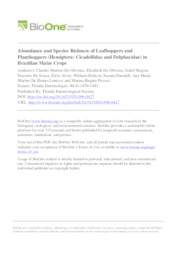Abundance and species richness of leafhoppers and planthoppers (Hemiptera: Cicadellidae and Delphacidae) in Brazilian maize crops.
Abundance and species richness of leafhoppers and planthoppers (Hemiptera: Cicadellidae and Delphacidae) in Brazilian maize crops.
Author(s): OLIVEIRA, C. M. de; OLIVEIRA, E. de; SOUZA, I. R. P. de; ALVES, E.; DOLEZAL, W.; PARADELL, S.; REMES LENICOV, A. M. M.; FRIZZAS, M. R.
Summary: Insects in the Cicadellidae and Delphacidae families, common in grasses, are an important group of vectors of viruses and mollicutes, which cause diseases in several plant species. The goal of this study was to evaluate the abundance and species richness of Cicadellidae and Delphacidae and the presence of potential vectors of viruses and mollicutes in maize crops in Brazil. Insects were collected using sweep nets in maize crops in 48 counties of 8 states, distributed in 4 regions of Brazil in the yr 2005, 2006 and 2007, with a total of 198 samples. The collected material was screened, and the leafhoppers and planthoppers were identified at the species level. A total of 4233 Cicadellidae specimens, including 30 species, and 205 Delphacidae specimens, including 9 species, were collected. The most abundant species was Dalbulus maidis (Delong & Wolcott) representing 90.1% of leafhoppers and planthoppers. Abundance and species richness differences were observed between the northeast and center-south regions of Brazil. Eight species of leafhoppers and planthoppers were identified as vectors or potential vectors of viruses and mollicutes in maize, although some of these viruses are not reported in Brazil. Among these species, we identified the planthoppers, Caenodelphax teapae (Fowler), Peregrinus maidis Ashmed Pyrophagus tigrinus Remes Lenicov & Varela and Toya propinqua (Fieber) are experimental vectors of Mal de Río Cuarto virus, which is a quarantine virus in Brazil. Two Cicadellidae species and 3 Delphacidae species were reported for the first time in Brazil.
Publication year: 2013
Types of publication: Journal article
Unit: Embrapa Maize & Sorghum
Keywords: Milho, Praga de Planta
Observation
Some of Embrapa's publications are published as ePub files. To read them, use or download one of the following free software options to your computer or mobile device. Android: Google Play Books; IOS: iBooks; Windows and Linux: Calibre.
Access other publications
Access the Agricultural Research Database (BDPA) to consult Embrapa's full library collection and records.
Visit Embrapa Bookstore to purchase books and other publications sold by Embrapa.

